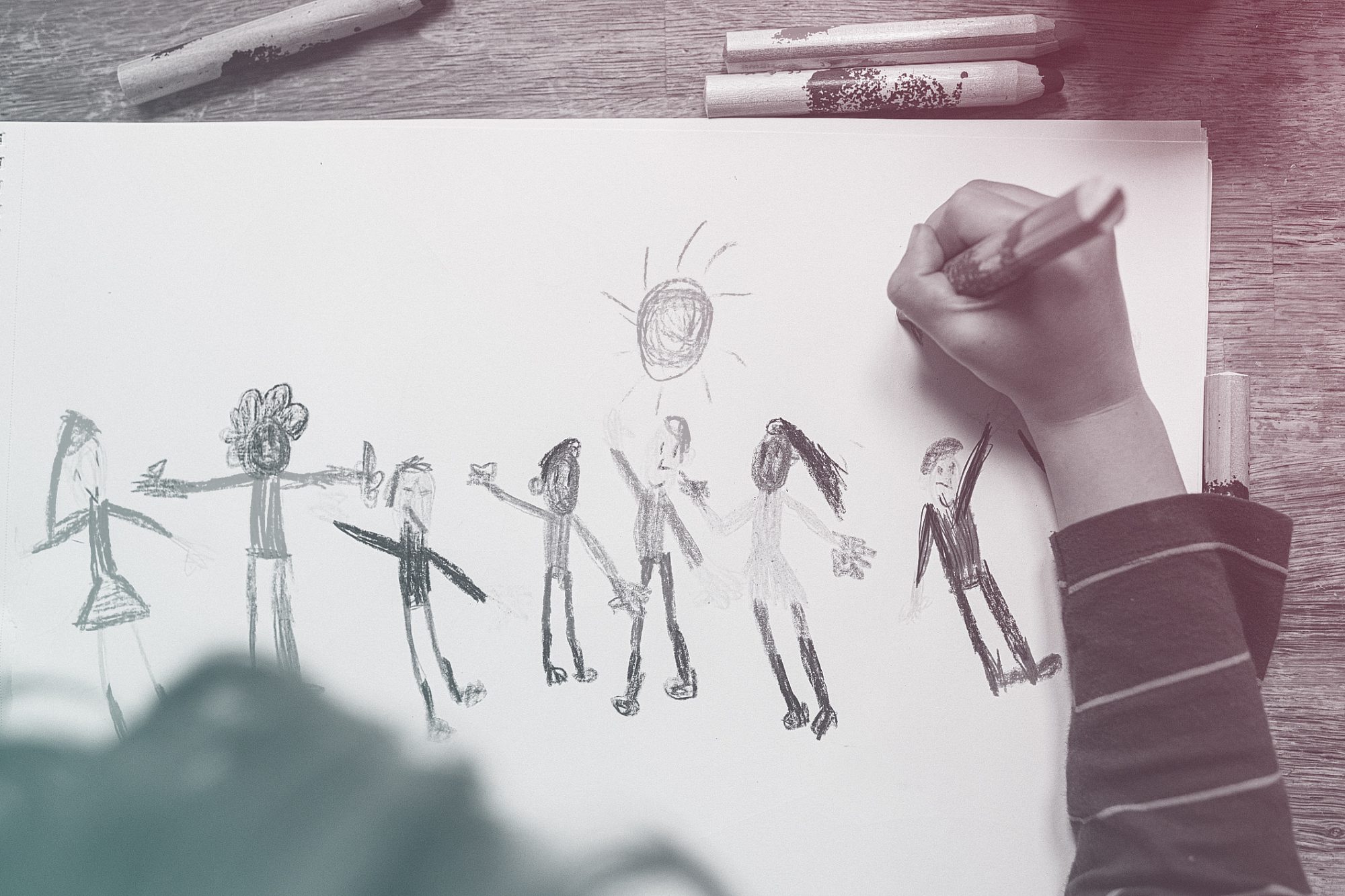
Desperate to add some levity to toddler mealtimes, my 2-year-old daughter and I began to play what soon became a favorite family game: Feelings Faces.
We would each pantomime emotions—sadness, surprise, or sleepiness—while asking each other to guess what feeling the other was acting out. She loved to point to a pretend owie when she was "hurt" or make puppy dog eyes when "sad."
Turns out, teaching kids to recognize and name emotions is a fun way to build the foundation for empathy. While there are many ways to define empathy, it is often defined as the ability to understand another person's perspective or emotional experience and relate to it while staying in control of your own emotions, says Jessie Stern, Ph.D., a researcher at the University of Virginia.
"Empathy means I understand you are sad, and I feel a little bit sad myself. But I don't become so distressed that the situation becomes about me," she says.
An essential skill for kids and grown-ups alike, empathy is a component of social-emotional development curriculums in preschools and even universities. Research shows that kids who are able to consider the feelings of others generally engage in more prosocial behavior, or actions intended to help others. In this way, empathy can be a tool for starting to unpack the country's long-standing racial tensions and harm that has been done by minoritizing families and communities, says Dr. Stern.
It's not until around 5 to 6 years old that kids can reliably take the perspective of others—a hallmark of empathy—notes Miller Shivers, Ph.D., a psychologist, and professor who works with young children and families at Lurie Children's Hospital in Chicago.
And there are ways parents can help kids begin to consider and care about the perspectives of others. Here are a few.
Chat About Favorites
Every time we're in the car for more than 15 minutes, my kids quiz me about my favorite sea creature. From their car seats, they discuss why I love sea turtles today when I loved otters yesterday. Then we chat about the merits of otters as opposed to whales—my 6-year-old's long-standing favorite animal.
Learning that Mama's favorite sea animal was different from hers initially perplexed my daughter. Is it OK for her to have a different favorite animal than Mama? How could Mama not also love the whale best of all?
Discussing favorites—foods, jungle animals, or songs—with kids as young as 2 or 3 helps them begin to realize and accept that other perspectives exist, says Chuck Kalish, Ph.D., a retired professor of educational psychology and senior advisor at the Society for Research in Child Development.
When kids begin to understand that other people have different preferences from theirs, they are further along the path to realizing that others have different feelings.
Practice—Don\’t Just Preach—Kindness
Modeling empathy is perhaps the most effective way to teach it to kids, says Dr. Stern. Caregivers who regularly respond to their children's distress with empathetic care give kids first-hand experience with empathy.
"It's really not so much about what parents say they value, but the values they actually embody," she says.
That's why having and displaying empathy toward small children—yep, even during a meltdown—is essential.
Kids are also famous for sensing parental hypocrisy. If young children are instructed to be kind, but aren't themselves spoken to or treated kindly, they will not internalize the value of kindness, says Dr. Stern.
Direct Empathy Inward
Susan Verde, author of The New York Times bestselling children's book, I Am Human says that a longtime mindfulness practice helped her cultivate the inner patience she needs to respond to her children's needs.
And mindfulness practice need not involve chic yoga gear or hours in lotus pose, she says. It can be as simple as pausing, taking deep breaths, and considering whether you're projecting your own baggage onto your children or truly responding to their needs.
"As parents and as moms, our self-talk is not always very nice. So it's about working to shift it to, 'I'm doing OK," she says.
She also notes aloud that she's not perfect. "I still mess it up, but I have some awareness of it. And when I mess it up, I say I messed it up," says Verde.
Allowing kids to hear this kind of forgiving, empathetic self-talk, normalizes it and gives them a script to follow themselves.
Practice Empathy in Other Areas of Your Life
Modeling empathy toward a co-parent, neighbor, or stranger adds up, Dr. Shivers says, as it demonstrates perspective-taking as well as responding with kindness.
"You could be walking along with your children and see someone lose her hat. You can say, 'Oh, that lady just dropped her hat. Now her head is probably cold. Let's quickly rescue her hat for her,'" Dr. Shivers explains.
This kind of modeling empowers children to act out of empathy and kindness themselves.
Let Your Kids Feel All the Feels
Fibbing to a toddler about the death of a family dog or avoiding talking about a sick grandparent might seem like ways to spare a child's feelings. But doing so can rob kids of the opportunity to experience universal emotions like sadness and loss, says Dr. Shivers.
And when kids don't experience negativity themselves—and then learn how to cope with these big feelings in healthy ways—they lack the basis for understanding the negative experiences of others, experts say.
Instead, acknowledge and normalize sad moments. Kids may need to hear that sadness is OK and that they're not alone in their feelings.
"There are certain basic human qualities and emotions that we all share. Because of that, there is this true connection between people," says Verde. "Recognizing humanity in somebody else can help us act from a place of connection and kindness."
Show Your True Colors
Kids can also benefit from seeing their parents express negative emotions in appropriate doses, Dr. Shivers says.
If you're feeling sad, for example, it's OK to be open with her child, says Dr. Shivers. After all, your child might even be able to sense your change in emotions. As long as tears don't become a daily occurrence and the anger is expressed appropriately, authentic emotional experiences are healthy ones to showcase. "It's not all roses and sunshine," says Dr. Shivers. "That's not real."
Use a Script
Providing a structure for talking through conflict situations can help your child approach conflict more independently and ultimately learn empathy. Parents can guide empathetic conversations without controlling them.
At Montessori Community School in Honolulu, guidance teacher Kylie Dunn uses the Peace Rose, a short script for kids to follow as they work through disagreements. The script begins with a mutual acknowledgment: "It looks like we are having a problem. Let's see if we can find a peaceful way to resolve it." This type of language gives a child a chance to say what happened and how it made them feel. The script then instructs children to make a suggestion for a peaceful resolution.
"Empathy requires practice," says Dunn. "We can't freak out if they have an opportunity and bungle it. If they do, we help them think through that mistake, not to feel shame or failure, and give another opportunity in the future."
Widen Your Circle
Many social scientists say that it's sometimes even tricky for adults to have empathy for those from extremely different cultural backgrounds without regular interactions. "It takes spending time with a person to imagine their experience and to know what would make them feel included or excluded," explains Dr. Kalish. "And it can be hard to take someone's perspective that's different from you without putting in that time."
During a global pandemic, spending time in different neighborhoods or visiting friends who have different cultural backgrounds is hard. But watching movies or reading books with a protagonist who looks different than you and your family or who comes from different places is a good alternative step, Dr. Kalish says.
Fictional stories, in particular, give kids a chance to consider the internal feelings, motivations, and worlds of people unlike themselves.

